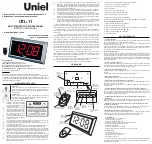
VESDA
®
Refrigerated Storage Design Guide
Table 4 – Design guidelines for VESDA fire alarm settings
[17]
.
Enclosure Size
Small < 500 m
2
(5400 sq.ft)
Medium 500 –
1000 m
2
(5400 –
10800 sq.ft)
Large 1000 –
1500 m
2
(10800
– 16200 sq.ft)
Extra Large
> 1500 m
2
(16200 sq.ft)
Fire Alarm (General
10 m (30 ft) or less)
2%obs/m
(0.61%obs/ft)
2%obs/m
(0.61%obs/ft)
1.5%obs/m
(0.46%obs/ft)
1%obs/m
(0.31%obs/ft)
Fire Alarm
(High Ceiling more
than 10 m (30 ft))
1.5%obs/m
(0.46%obs/ft)
1.5%obs/m
(0.46%obs/ft)
1%obs/m
(0.31%obs/ft)
1%obs/m
(0.31%obs/ft)
Maximum Transport
Time Allowed per
Zone (s)
See Note Below
and consult local
codes.
110 110 110
Note:
For small enclosures, the Maximum Transport Time Allowed is a function of the ceiling
height H and equals 0.14H – 0.8H + 80. If the Maximum Transport Time Allowed cannot be
achieved, install additional detectors in the area. If the Transport Time is close to the maximum
allowed, consider reducing the fire alarm threshold by 10 to 20% to compensate. Ceiling height
restrictions are for FM approval. Remember also to consult local codes and standards for Transport
Time requirements.
5.6 Battery
Backup
When using a VESDA system for pre-action suppression activation, in the event of a power outage,
a secondary power supply MUST be available. This power supply needs to be capable of running a
single VESDA detector for a total of 90 hours. This is in compliance with the fact that approved
control panels for the automatic release of pre-action or deluge sprinkler systems must have 90
hours of standby power plus 10 minutes worth of power to operate the sprinkler system and
alarms
[17]
.
Where the VESDA system is being used for very early warning smoke detection alone, refer to
local codes and standards for the battery backup required.
6. Ongoing
Considerations
6.1
Running The VESDA System
For a new refrigerated storage facility, it is preferable that the VESDA system be powered up and
running while the refrigerators are being commissioned. This allows the detectors to adjust
gradually to the decreasing sampled air temperature.
If installing VESDA detectors in an existing facility, it is recommended that the pipe network inside
the refrigerated areas be installed first and that all points where pipes exit these areas be blocked
off. This prevents humid air being transferred into the protected area from outside. The blockages
can be removed once the rest of the pipe network and detectors, outside the refrigerated areas,
have been installed and connected.
Note:
It may be necessary to construct enclosures around detectors to protect them from the
weather or mechanical damage.
17






































